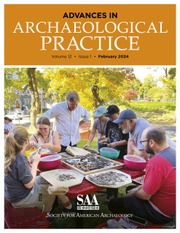Article contents
Monitoring Shoreline Erosion at Calusa Island: A Community-Accessible Method
Published online by Cambridge University Press: 04 March 2025
Abstract
At coastal archaeological sites, measuring erosion rates and assessing artifact loss are vital to understanding the timescale(s) and spatial magnitude of past and future site loss. We describe a straightforward low-tech methodology for documenting shoreline erosion developed by professionals and volunteers over seven years at Calusa Island Midden (8LL45), one of the few remaining sites with an Archaic component in the Pine Island Sound region of coastal Southwest Florida. We outline the evolution of the methodology since its launch in 2016 and describe issues encountered and solutions implemented. We also describe the use of the data to guide archaeological research and document the impacts of major storms at the site. The response to Hurricane Ian in 2022 is one example of how simply collected data can inform site management. This methodology can be implemented easily at other coastal sites at low cost and in collaboration with communities, volunteers, and heritage site managers.
Resumen
Cuando nos enfrentamos a un sitio arqueológico que se deteriora, el primer paso es evaluar y documentar las condiciones. En los sitios costeros, es esencial medir las tasas de erosión y evaluar la pérdida de artefactos para comunicar la escala de tiempo y magnitud de la pérdida pasada y futura del sitio. Describimos una metodología sencilla de baja tecnología para documentar la erosión en la costa, desarrollada por profesionales y voluntarias(os) a lo largo de siete años en la isla Calusa, uno de los pocos sitios del período Arcaico que quedan en la región de Pine Island Sound, en el suroeste de Florida. Resumimos la evolución de la metodología desde su instalación en 2016 y describimos los problemas encontrados y las soluciones implementadas. También proporcionamos ejemplos de la utilidad de la metodología para orientar la investigación arqueológica y para documentar los impactos de las grandes tormentas en el sitio de la isla, incluido el huracán Ian en 2022. Esta metodología se puede implementar fácilmente en otros sitios costeros a bajo costo y en colaboración con voluntarias(os) de la comunidad local y gestoras(es) de sitios patrimoniales.
Keywords
Information
- Type
- How to Series
- Information
- Advances in Archaeological Practice , Volume 12 , Special Issue 3: Monitoring Heritage at Risk Sites in Rapidly Changing Coastal Environments , August 2024 , pp. 289 - 301
- Copyright
- Copyright © The Author(s), 2025. Published by Cambridge University Press on behalf of Society for American Archaeology
References
References Cited
- 1
- Cited by

